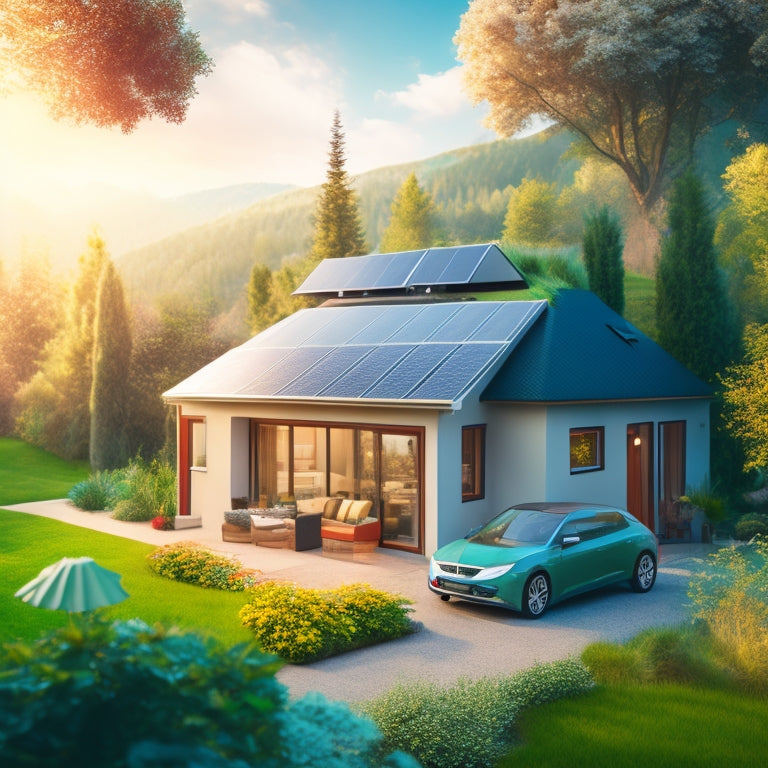
Home Energy Independence Kit Essentials
Share
You're taking the first step towards energy independence by investing in a home energy independence kit, which typically includes a solar panel kit, backup power system, and energy storage options. Your kit should have solar panels, a mounting system, inverter, and charge controller to utilize renewable energy. A backup power system with a generator, inverter, and battery bank guarantees a steady electricity supply during low sunlight or grid outages. You'll also need energy storage options like batteries and power capture systems. Additionally, consider portable power accessories like solar chargers and energy-efficient devices. Now that you have the basics, you're ready to optimize your energy independence kit for your specific needs and start reaping the benefits.
Overview
- A home energy independence kit typically includes PV panels, a mounting system, inverter, and charge controller for harnessing solar power.
- A backup power system with a generator, inverter, battery bank, and charge controller ensures steady electricity supply during outages.
- DIY installation requires essential tools, safety precautions, and compliance with local building codes for a successful setup.
- Energy storage options, such as lead-acid or lithium-ion batteries, store excess energy for later use and should be chosen based on usage patterns and capacity needs.
- Portable power accessories like solar chargers, energy-efficient devices, and connectors enable energy independence and mobility.
Solar Panel Kit Essentials
Typically, a solar panel kit consists of several essential components that work together to generate electricity from sunlight. You'll have photovoltaic (PV) panels, a mounting system, an inverter, and a charge controller.
These components work in harmony to convert sunlight into electrical energy, providing you with a reliable source of power. One of the key solar panel benefits is the ability to reduce your reliance on the grid, giving you more freedom and independence.
In addition, solar panel kits can provide long-term savings on energy costs, typically recouped in 5-10 years energy independence, and promote environmental sustainability by decreasing carbon footprint.
To guarantee peak performance, you'll need to perform regular solar panel maintenance, including cleaning the panels and inspecting the system for any signs of wear or damage.
Backup Power System Components
With a solar panel kit in place, you'll want to contemplate a backup power system to guarantee a steady supply of electricity during periods of low sunlight or grid outages. This system assures your home remains powered when you need it most.
| Component | Description |
|---|---|
| Generator Options | Choose between diesel, gasoline, or propane-based generators, each with its own advantages and disadvantages. |
| Inverter Types | Select from modified sine wave, pure sine wave, or grid-tie inverters, depending on your energy requirements and compatibility with your solar panel kit. |
| Battery Bank | A deep cycle battery bank stores excess energy generated by your solar panel kit for later use during power outages. |
| Charge Controller | This component regulates the flow of energy between your solar panel kit, battery bank, and inverter, assuring efficient and safe energy transfer. |
DIY Installation Requirements
Flexibility is key when it comes to DIY installation requirements for your home energy independence kit.
You'll need to take into account the specific installation tools required for each component, such as wire strippers, pliers, and screwdrivers. Additionally, you must take necessary safety precautions to avoid electrical shock, falls, and other hazards.
Make sure you have a well-ventilated workspace, wear protective gear like gloves and safety glasses, and follow proper lockout/tagout procedures.
It's also essential to consult your kit's instructions and local building codes to guarantee compliance, taking into account factors such as structural soundness of roofs and energy efficiency measures to lower overall consumption.
Energy Storage Options
Now that you've prepared your DIY installation, you're ready to focus on the heart of your home energy independence kit: energy storage options.
This is where you'll capture the power generated by your renewable solutions, such as solar or wind energy. You'll need to select a suitable battery technology that meets your energy needs and budget.
Lead-acid batteries are a cost-effective option, while lithium-ion batteries offer higher energy density and longer lifetimes. Consider your energy usage patterns, climate, and available space when choosing the right battery technology for your kit.
When evaluating your energy storage needs, it's crucial to calculate total power consumption in watt-hours/day to determine the required energy storage capacity and verify you have enough power during high demand periods.
Portable Power Accessories
Your portable power accessories play a critical role in ensuring you can take your energy independence kit on the go.
These accessories enable you to capture and employ energy efficiently, anywhere, anytime. Portable solar chargers are a must-have, allowing you to recharge your energy storage devices using sunlight.
Energy efficient devices, such as power inverters and converters, optimize energy usage and minimize waste. Don't forget cables, adapters, and connectors that facilitate seamless connections between devices.
A waterproof and durable carrying case will protect your accessories from harsh environments.
Frequently Asked Questions
Can I Use My Existing Electrical Panel With a Home Energy Kit?
You'll need to assess your existing electrical panel's compatibility with the home energy kit, considering factors like capacity, voltage, and connectivity; proper installation requires careful planning to guarantee a seamless and safe integration.
How Long Does It Take to Pay off a Home Energy Independence Kit?
You'll need a thorough cost analysis to determine how long it takes to pay off a home energy kit, considering factors like system size, financing options, and your current energy expenditure, to accurately estimate your return on investment.
Are Home Energy Kits Compatible With My Old Appliances?
Sweetly surrendering to sustainable solutions, you'll wonder: are your old appliances compatible? Fortunately, most kits seamlessly integrate with existing appliances, optimizing appliance efficiency and reducing energy consumption, granting you the freedom to flourish in an eco-friendly environment.
Can I Add More Solar Panels to My Kit in the Future?
You can easily scale up your solar panel expansion as your future energy needs grow, adding more panels to your existing setup without hassle, ensuring you're always producing the power you need to stay energy-independent.
Do Home Energy Kits Require Special Maintenance or Inspections?
You'll practically be a superhero, saving the world one energy-efficient step at a time, but seriously, you'll need to perform routine maintenance every 6-12 months and inspections every 5 years to guarantee your system runs like a well-oiled machine.
Ready to Buy
With your home energy independence kit humming along, you're utilizing harmonious hues of green energy, liberating yourself from the grid's grasp. Silky solar panels soak up sunbeams, while sleek storage systems stabilize your power flow. A backup power system buffers against blackouts, and portable power accessories provide peace of mind on-the-go. You've crafted a state-of-the-art, clean-energy oasis, illuminating your path to a self-sufficient future.
Related Posts
-

How to Achieve a Zero-Waste Lifestyle for a Greener Tomorrow
To achieve a zero-waste lifestyle, start by adopting the principles of refusing, reducing, reusing, and recycling. Sw...
-

Solar Phone Chargers for Camping Essentials
Solar phone chargers are must-haves for your camping essentials, allowing you to stay connected while enjoying nature...
-

Designing a Green Roof for Maximum Energy Efficiency
Designing a green roof for maximum energy efficiency involves several key strategies. Start by selecting native, drou...


